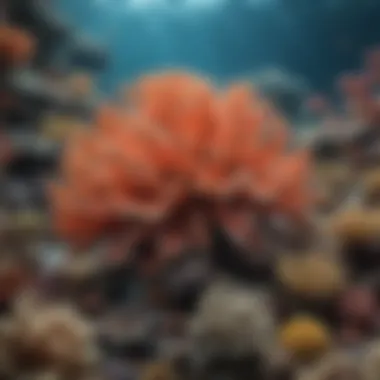The Impact of Climate Change on the Great Barrier Reef


Intro
Climate change represents a profound challenge for ecosystems around the globe, but perhaps none is as intricately affected as the Great Barrier Reef. This natural wonder, spanning over 2,300 kilometers along the northeastern coast of Australia, is not only the largest coral reef system in the world but also a critical habitat for diverse marine life. The health of this ecosystem is paramount, not only for the organisms it harbors but also for the human populations that rely on it for their livelihood. The:
- Aquaculture sectors
- Tourism industries
- Fisheries
all find their basis in the vitality of the reef. Therefore, understanding the impact of climate change is essential for conserving this valuable resource and ensuring its sustainability.
Research Overview
In this section, we will delve into the methodologies and rationale that underlie current research on the Great Barrier Reef's ecological status amid climate change. Researchers employ a variety of approaches to gain insight into the complex interactions that characterize this ecosystem.
Methodological Approaches
Various techniques contribute to our understanding of the reef's resilience and vulnerability. These techniques include:
- Remote Sensing: Satellite imagery helps track changes in sea temperature and coral cover.
- Field Studies: In situ observations offer real-time data on marine biodiversity and health.
- Modeling: Predictive models simulate future scenarios under different climate change trajectories.
The integration of these methodologies is essential to accurately assess the environment and ecological shifts occurring within the reef.
Significance and Implications
The implications of these research findings extend beyond academic realms. Policymakers and conservationists rely on data to formulate effective strategies that can help mitigate the adverse effects of climate change. For instance, understanding coral bleaching patterns is crucial for developing targeted conservation efforts to protect sensitive areas. Furthermore, research underscores the interconnectedness of global climate systems, juxtaposing the health of the reef with broader environmental policies.
Current Trends in Science
The scientific community continues to innovate in its approaches to studying and preserving the Great Barrier Reef. Awareness of climate dynamics and technological advancements are key in these endeavors.
Innovative Techniques and Tools
Researchers are now utilizing cutting-edge tools that enhance our perception of coral ecosystems. Among these are:
- Drones: For aerial monitoring and mapping of reef structures.
- Environmental DNA (eDNA): This method detects species presence through genetic material shed into the environment, allowing for a more comprehensive biodiversity assessment.
- Artificial Intelligence: AI algorithms analyze large datasets for patterns, including fish populations and coral health.
These innovations offer new pathways for conservation efforts and provide deeper insights into the reef's responses to climate pressures.
Interdisciplinary Connections
The study of the Great Barrier Reef interlinks various disciplines. Environmental science, marine biology, economics, and sociology all converge in efforts to address climate change's multifaceted challenges. Collaborations across fields can foster more holistic approaches to ecosystem preservation.
"Understanding the Great Barrier Reef's dynamics requires not only scientific insight but also collaborative efforts across multiple disciplines to achieve meaningful conservation outcomes."
This collective groundwork is essential in forming public policies that safeguard both the environment and the communities that depend on the reef. As research evolves, attention to climate change's impacts remains crucial, demanding ongoing dedication to explore effective preventative measures.
Prolusion to Climate Change and Marine Ecosystems
Understanding the interaction between climate change and marine ecosystems is essential. Marine ecosystems, which encompass coral reefs, mangroves, and various seawater habitats, serve as critical environmental entities that sustain numerous species. They provide vital services such as carbon sequestration, shoreline protection, and support for fish stocks that are crucial for human livelihoods. The effects of climate change threaten these ecosystems and, consequently, the benefits they provide.
Climate change affects marine environments predominantly through rising temperatures, altered salinity levels, and changes in ocean currents. These factors contribute to the degradation of habitats and the displacement of species, which impacts biodiversity. This section will set the stage for understanding specific threats to the Great Barrier Reef, a powerful example of a marine ecosystem under pressure from climate change.
Defining Climate Change
Climate change refers to significant long-term changes in temperature, precipitation, wind patterns, and other elements of the Earth's climate system. Primarily driven by human activities, such as the burning of fossil fuels and deforestation, climate change results in increased levels of greenhouse gases in the atmosphere.
As these gases trap heat, the impact on global temperatures becomes clear. The Intergovernmental Panel on Climate Change (IPCC) indicates a rise of 1.1 degrees Celsius since the late 19th century. This seemingly small number indicates profound changes for ecosystems, particularly marine ones like the Great Barrier Reef.
Effectively, climate change alters marine habitats, triggering coral bleaching, ocean acidification, and shifts in species distributions, all leading to ecological instability.
Overview of Marine Ecosystems
Marine ecosystems consist of diverse environments, including deep-sea trenches, coral reefs, and coastal regions. They harbor a vast array of organisms, ranging from microscopic plankton to large whales. Notably, coral reefs are one of the most biodiverse ecosystems on the planet, containing thousands of species of fish, invertebrates, and plants.


These ecosystems provide numerous ecological and socio-economic benefits:
- Biodiversity: High biological diversity supports ecosystem resilience.
- Fisheries: Many coastal communities rely on marine ecosystems for their livelihoods through fishing and tourism.
- Climate Regulation: Oceans act as carbon sinks, absorbing a significant portion of CO2 emissions.
Understanding these elements is crucial in recognizing the severe implications of climate change on these systems. Marine ecosystems are not isolated; the consequences impact not only marine life but also human communities that depend on them.
"The ocean is the world's largest carbon sink, yet it is facing unprecedented changes due to climate change."
Addressing these issues forms the basis for evaluating the specific impacts on the Great Barrier Reef and the necessary measures to mitigate these effects.
The Great Barrier Reef: An Overview
The Great Barrier Reef, stretching over 2,300 kilometers, is not just a natural wonder; it is a crucial component of marine biodiversity and ecological balance. Understanding this ecosystem is key to comprehending the broader impact of climate change on marine life. Within its vibrant coral structures live thousands of species, making it one of the richest ecosystems on the planet. This section delves into the geography and biodiversity of the Great Barrier Reef, and explores its ecological significance for both marine life and human communities.
Geography and Biodiversity
The geography of the Great Barrier Reef encompasses a vast area along the northeastern coast of Australia. It is a complex system comprising approximately 3,000 individual reefs and around 600 tropical islands. This diversity in habitat supports an array of marine species, including fish, mollusks, and marine mammals. The reef is home to over 400 types of coral, 1,500 species of fish, and numerous other organisms.
Fishing and tourism contribute significantly to the local economy, highlighting the importance of the reef in maintaining ecological balance. With such biodiversity, any shifts in environmental conditions can have cascading effects. For example, shifts in water temperature can affect coral growth and resilience. It is essential to monitor these ecological changes to inform conservation efforts.
Ecological Significance
The ecological importance of the Great Barrier Reef is far-reaching. As a biodiversity hotspot, it serves as a breeding ground for many species and a sanctuary for endangered marine life. The reef supports fisheries that are vital for local communities, providing food and economic opportunities.
Moreover, the Great Barrier Reef plays a critical role in protecting coastlines from erosion. The coral structures absorb wave energy, reducing the impact of storms on coastal areas. This natural barrier is crucial, especially as climate change increases the frequency of severe weather events.
"The Great Barrier Reef is a significant contributor to the ecological stability of the marine environment. Its preservation is not just a local concern but a global necessity."
In summary, an understanding of the geography and biodiversity of the Great Barrier Reef, as well as its ecological significance, is essential. It lays the foundation for comprehending how climate change, through its various mechanisms, poses threats to this irreplaceable ecosystem.
Preserving the Great Barrier Reef is not only beneficial for marine life; it is also vital for human communities that rely on its resources and ecological benefits. Thus, it is imperative to take a proactive approach in safeguarding this natural treasure.
Mechanisms of Climate Change Affecting the Reef
Understanding the mechanisms of climate change that affect the Great Barrier Reef is essential for grasping the complex dynamics at play within this ecosystem. Such knowledge not only highlights the severity of these changes but also illuminates the necessary steps that can be taken to mitigate their impact. The mechanisms include rising sea temperatures, ocean acidification, and extreme weather events. Each of these elements has unique implications for coral health and marine biodiversity, making them critical aspects of the discourse on climate change.
Rising Sea Temperatures
Rising sea temperatures are one of the most significant consequences of climate change impacting the Great Barrier Reef. As global temperatures increase, ocean waters also warm, leading to a range of adverse effects on coral ecosystems. Corals have a narrow range of temperature tolerance. Prolonged exposure to elevated temperatures can cause coral bleaching, a phenomenon where corals expel the symbiotic algae living within their tissues. This loss not only diminishes the vibrancy of the reef but also deprives it of a key source of energy.
Coral bleaching due to higher temperatures results in decreased biodiversity as coral species struggle to survive outside their optimal temperature ranges. The subsequent reduction in coral cover affects numerous marine species that depend on the reef for habitat and food. Without adequate intervention, the future viability of the reef is at risk.
Ocean Acidification
Ocean acidification is another direct consequence of increased atmospheric CO2, which dissolves into seawater and lowers the pH. This chemical shift impacts calcifying organisms, including corals, by hindering their ability to produce calcium carbonate structures—their skeletons. With more acidic conditions, corals become more susceptible to erosion and less capable of recovering from stress events.
Moreover, the effects of acidification extend beyond corals to various marine species reliant on calcium carbonate for their shells and skeletons, such as mollusks and certain types of plankton. Changes in these populations can disrupt the entire marine food web, influencing everything from fish populations to human fishing industries.
Extreme Weather Events
Extreme weather events, such as hurricanes and cyclones, have become more frequent and severe due to climate change. These events can cause physical damage to the Great Barrier Reef, breaking apart coral structures and leading to significant habitat loss. High wave energy and sedimentation from storm surges can suffocate corals and other marine life, leading to a steep decline in biodiversity.
"The relationship between climate change and extreme weather is increasingly evident, highlighting the urgent need for adaptive strategies in marine conservation."
The socio-economic implications for communities dependent on the reef for tourism and fishing are profound. Damage from extreme weather can lead to long-term declines in fish stocks and detract from the allure of the reef as a tourist destination. Overall, understanding these mechanisms is vital for developing effective strategies that address the multifaceted impacts of climate change on the Great Barrier Reef.
Coral Bleaching: A Direct Consequence
Understanding Coral Bleaching
Coral bleaching occurs when corals, experiencing stress from various environmental factors, expel the symbiotic algae (zooxanthellae) living in their tissues. These algae are essential for corals because they provide energy through photosynthesis and contribute to the vibrant colors we associate with healthy reefs. When corals confront stressors—most notably rising sea temperatures, but also factors like pollution and ocean acidification—they react negatively. In the face of prolonged stress, corals lose their color and turn white, indicating a bleached state, which can lead to a drastic decline in health and, ultimately, death if conditions do not improve.


The importance of coral bleching can be summarized as follows:
- Ecological impact: Healthy coral reefs support over a quarter of all marine species. Bleached corals can lead to loss of biodiversity.
- Economic effects: Many communities rely on reefs for fishing and tourism. Coral degradation affects these livelihoods directly.
- Indicator of environmental change: Bleaching serves as an urgent signal for the overall health of marine ecosystems amid climate change.
Recent Bleaching Events
Recent data highlights several alarming coral bleaching events over the past years. Notable incidents include:
- 2016 and 2017: Major bleaching events recorded in the Great Barrier Reef, attributed primarily to record-breaking sea temperatures.
- Ongoing assessments show that about 50% of the corals have suffered from some form of bleaching over the last five years.
"Coral bleaching is not just a phenomenon; it is a wake-up call to the state of our oceans and the urgent need for change."
These events illustrate a concerning trend that is not only about losing biodiversity but also about the resilience of marine ecosystems. Affected reefs struggle to recover, leading to further instability within the marine environment. As sea temperature continues to rise, the frequency and severity of bleaching events may increase, emphasizing the need for intervention and sustainable practices.
Addressing coral bleaching through study and conservation efforts is critical to maintaining the health of the Great Barrier Reef and understanding the broader implications of climate change on marine life.
Impact on Marine Biodiversity
The Great Barrier Reef supports a diverse array of marine life, making it a significant focus in discussions about climate change. This biodiversity is crucial for maintaining ecosystem balance and health. As climate change progresses, various species face unprecedented threats. These threats disrupt not just the species' population but also the intricate relationships within this marine ecosystem. Understanding the consequences of climate change is essential.
Species at Risk
Many species within the Great Barrier Reef are becoming increasingly vulnerable due to climate change. For instance, coral species like Acropora are particularly affected by rising sea temperatures. Their sensitivity to temperature fluctuations leads to coral bleaching, a phenomenon that significantly diminishes their resilience. Moreover, marine species such as sea turtles and certain fish, reliant on coral structures for habitat and food, also face existential threats.
It is estimated that over 30% of the Great Barrier Reef's coral cover has vanished due to climate-related stresses.
The impact extends beyond corals. Species like the clownfish rely on the anemones that in turn depend on healthy coral ecosystems. The delicate balance is disrupted by warming waters, leading to population declines. The loss of biodiversity results in a diminished ability for ecosystems to recover from stress, making conservation efforts increasingly urgent.
Changes in Ecosystem Dynamics
Climate change modifies the dynamics of marine ecosystems. The delicate relationships between species that characterize the Great Barrier Reef begin to unravel. Once stable populations of herbivores like parrotfish face reduced food supplies, leading to potential overgrowth of algae on coral. Such changes can initiate a detrimental cycle that further impairs coral health.
In addition, shifts in species distribution are becoming more pronounced. Warmer waters drive certain species toward cooler areas, while others may not be able to adapt quickly enough. This can lead to mismatched predator-prey relationships, disrupting feeding patterns and reproductive cycles.
The interconnectedness of species means that the decline in one species can propagate effects throughout the ecosystem. Marine biodiversity relies on balance. As climate change accelerates, the inherent resilience of the Great Barrier Reef reduces, igniting a cascade of effects that could alter the reef's composition forever.
Socioeconomic Implications
The socioeconomic implications of climate change on the Great Barrier Reef are extensive and significant. This section illuminates the ways in which environmental shifts directly impact human livelihoods and the economy of the surrounding regions. The Great Barrier Reef is not only a natural wonder but also a crucial source of income and resources for many communities. Understanding these implications sheds light on the urgency of addressing climate change.
Tourism and Local Economies
Tourism plays a vital role in the economy of regions surrounding the Great Barrier Reef. Millions of visitors each year seek to experience its beauty and biodiversity. This industry generates billions in revenue, creating jobs in sectors like hospitality, transportation, and recreation. However, as climate change progresses, the health of the reef is compromised.
Coral bleaching due to rising sea temperatures not only affects marine life but also diminishes the visual appeal of the reef. This degradation can lead to a decline in tourist visits, impacting local businesses reliant on this influx for survival. Many tour operators face uncertainty about the future sustainability of their trips.
- Losses in Revenue: A decreased number of tourists leads to less spending in local economies, affecting jobs and services.
- Job Security: Employment in tourism can become unstable as conditions worsen, with potential layoffs and business closures.
- Investment Risks: Business investors are less inclined to invest in an area that faces ecological decline.
Fisheries and Food Security
Fisheries are another critical component of the socioeconomic landscape connected to the Great Barrier Reef. Local communities depend on fishing for their food and income. However, climate change poses several threats to these fish stocks:
- Habitat Disruption: Changes in water temperature and acidity can affect the habitats where fish thrive, leading to reductions in stock sizes.
- Species Migration: As ocean conditions change, some species may move to cooler waters. This can disrupt local fishing patterns and impact the livelihoods of fishermen.
- Food Supply: A decline in fish populations not only affects local incomes but also threatens food security for populations that rely on fish as a primary source of nutrition.
"The health of the Great Barrier Reef is interconnected with the lives of many, influencing both the economy and the community's access to food."
Mitigation and Adaptation Strategies
Mitigation and adaptation strategies are essential components in addressing the severe effects of climate change on the Great Barrier Reef. They prioritize preventing the ongoing degradation of this unique ecosystem and enhancing its resilience against future impacts. The strategies fall into two broad categories: mitigation focuses on reducing greenhouse gas emissions, while adaptation involves adjusting practices and systems to minimize adverse impacts.
Effective mitigation requires a concerted effort to lower carbon emissions at both global and local levels. This includes transitioning to renewable energy sources such as solar and wind power, improving energy efficiency, and promoting sustainable transportation methods. Collective action on an international scale can significantly lessen the pressures on the Great Barrier Reef by targeting the root causes of climate change.


Adapting to the current and projected changes is equally important. Such strategies may involve:
- Improving water management to reduce pollution and runoff, which can harm coral health.
- Restoration of coastal ecosystems like mangroves and seagrasses that protect the reef from erosion and act as carbon sinks.
- Implementing sustainable fishing practices to allow fish populations and coral systems to recover.
Successful adaptation also hinges on scientific research and monitoring. Understanding ongoing changes to the reef ecosystem can inform management actions. This could involve deploying sensors to monitor sea temperatures and water quality, allowing for real-time response to detrimental changes.
"Adaptation strategies are vital for mitigating the impacts of climate change on marine ecosystems like the Great Barrier Reef, where immediate action is essential to preserve its future."
By focusing on mitigation and adaptation strategies, stakeholders can foster a dual approach to safeguarding the Great Barrier Reef. These efforts are not only beneficial to the reef but also to the communities that rely on it for their livelihood. Prioritizing these strategies may help develop a more sustainable and resilient future for both the reef and its surrounding environments.
Conservation Efforts
Conservation efforts play a pivotal role in the protection and recovery of the Great Barrier Reef. An integrated approach engages multiple stakeholders, including governments, conservation groups, and local communities. Such partnerships aim to enhance the overall health of marine ecosystems.
Concrete measures can vary from establishing marine protected areas to legislative action that limits harmful practices. For instance, the Australian Government has invested resources into the Reef 2050 Plan, which aims to improve water quality and reduce pollution threats. This coordinated strategy aims to protect the reef's biodiversity and increase its adaptive capacity.
Additionally, local community involvement is crucial. Engaging Indigenous populations who have traditional ecological knowledge can lead to more effective conservation practices. Their input helps tailor strategies to local environmental conditions and specific needs of the reef.
Innovative Technologies
Innovative technologies emerge as critical tools in the fight against climate change impacts on the Great Barrier Reef. Cutting-edge research and technological advancements hold promise to enhance conservation efforts and promote recovery.
- Artificial Intelligence (AI) is increasingly used to analyze vast amounts of data related to ocean conditions. It helps forecast coral bleaching events and allows researchers to act swiftly in response to potential threats.
- Remote sensing technologies provide valuable insights into reef health and changes. Drones and satellite imaging enable the monitoring of large areas, delivering real-time information crucial for decision-making.
- Innovative breeding programs focus on developing heat-resistant coral species. These programs aim to restore damaged reefs with more resilient coral that can withstand rising sea temperatures.
Investing in innovative technologies not only helps in conservation efforts but also raises awareness of the importance of protecting the Great Barrier Reef. Researchers and practitioners must continue to explore and integrate these advanced tools for effective management and sustainability.
Future Outlook for the Great Barrier Reef
The future outlook for the Great Barrier Reef is an essential topic in understanding the broader implications of climate change. This coral ecosystem, which provides habitat for numerous marine species, faces significant challenges that could reshape its structure and functionality in the coming years. Recognizing the trends and projections is crucial for informed decision-making regarding conservation and sustainability efforts.
Projected Climate Trends
The projected climate trends indicate a grim future for the Great Barrier Reef if current trajectories continue. Rising global temperatures lead to an increase in sea temperatures, which directly affects coral health. For instance, scientists warn that if temperatures rise by an additional 1.5 degrees Celsius, we might witness even more frequent and severe bleaching events.
Ocean acidification is another significant trend. As the ocean absorbs more carbon dioxide, its pH decreases, impacting the ability of corals to form calcium carbonate structures. This phenomenon poses a threat to the reef's structural integrity. Furthermore, changing weather patterns can lead to increased cyclone activity, which can cause physical damage to the reef.
The following key points summarize these trends:
- Increased average sea temperatures are leading to more frequent coral bleaching.
- Ocean acidity is rising, affecting coral growth and resilience.
- Shifts in weather patterns are causing more intense storms and cyclonic activity.
- Sea level rise continues, altering coastal ecosystems that are closely associated with the reef.
"If the current rate of change continues, we can expect a 70% decline in coral cover by 2040."
This statement highlights the urgency of taking action now to mitigate these trends.
Long-term Viability of Coral Reefs
The long-term viability of coral reefs, particularly the Great Barrier Reef, remains uncertain amid the pressing threats of climate change. If mitigation strategies are not imposed soon, we risk reaching a tipping point where recovery will become substantially longer or even impossible.
Research suggests that healthy coral reefs can recover from disturbances, but the frequency and severity of these disturbances today could hinder regeneration. Factors affecting long-term viability include:
- Resilience of coral species: Some species are more adaptive to change than others.
- Health of surrounding ecosystems: Connected habitats like mangroves and seagrasses are vital for reef sustainability.
- Human influences: Pollution and overfishing exacerbate the stress on reefs.
The End
Summary of Findings
In summarizing the findings, it is evident that climate change poses dire threats to the Great Barrier Reef. Specifically:
- Rising Sea Temperatures: This has led to increased frequency of coral bleaching events, undermining the resilience of coral species.
- Ocean Acidification: This chemical change reduces the availability of calcium carbonate, essential for coral growth and health.
- Extreme Weather Events: More frequent storms and changes in weather patterns disrupt marine life and damage coral ecosystems.
The implications extend to marine biodiversity. Many species that depend on the reef face habitat loss and food scarcity. Socioeconomic factors, such as tourism and fishing, will also suffer as the reef degrades. A grim future awaits if no substantial action is taken to mitigate these risks.
Call for Action
The call for action is urgent and should resonate with all stakeholders, including governments, non-profit organizations, and local communities. Effective conservation strategies are essential to protect the Great Barrier Reef. The following actions are pivotal:
- Strengthen Conservation Efforts: Emphasizing the need for protected marine areas and sustainable fishing practices can help conserve marine biodiversity.
- Invest in Research and Education: Increased funding for scientific research will deepen understanding of the reef's ecosystem and the effects of climate change.
- Promote Global Collaboration: Climate change is a global issue necessitating cooperation across countries to enact policies that reduce greenhouse gas emissions.
- Engage Local Communities: Developing initiatives that involve local populations can ensure that conservation measures are culturally relevant and effective.



